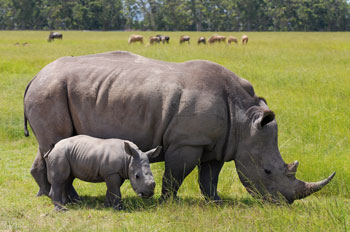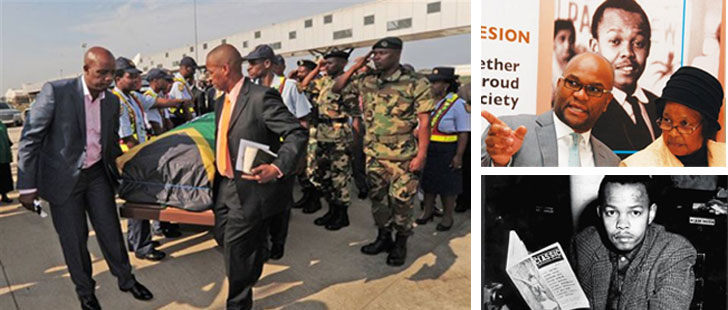| |
|
| |
PRESIDENT ZUMA ATTENDS 34TH ORDINARY SADC SUMMIT OF HEADS OF STATE AND GOVERNMENT |
| |
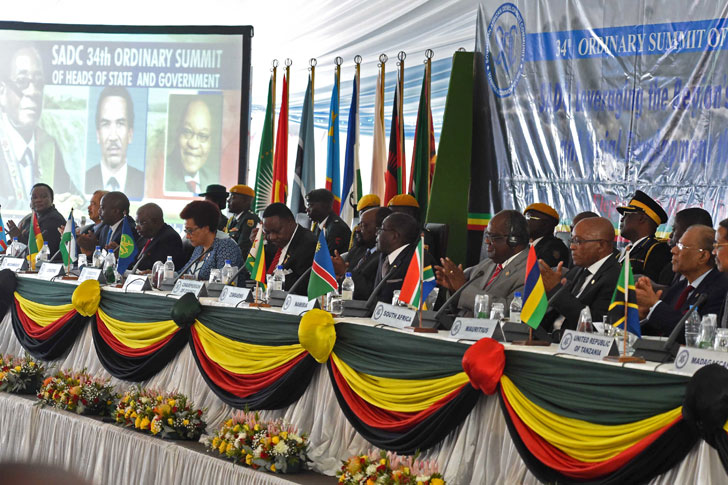 |
| |
The theme of the 2014 Summit was: “SADC Strategy for Economic Transformation: Leveraging the Region’s Diverse Resources for Sustainable Economic and Social Development through Beneficiation and Value Addition”. |
| |
President Jacob Zuma led the South African delegation at the 34th Ordinary Southern African Development Community (SADC) Summit of Heads of State and Government, from 17 to 18 August 2014 at Victoria Falls, Zimbabwe. Zimbabwe is the new Chair of SADC, taking over from the Republic of Malawi during this SADC Summit.
During the summit, the SADC deliberate on, among others, socio-economic issues that affect the region. In addition, the SADC leaders also considered the report on the review of the Regional Indicative Strategic Development Plan (RISDP). The RISDP is a comprehensive development and implementation framework guiding the regional integration agenda of SADC over a period of 15 years.
SADC is also defining a new development blueprint that is expected to shape the region’s integration agenda until 2050. In this regard, the SADC Vision 2050 was also discussed. The SADC Vision 2050 aims to provide a framework for a long-term vision for SADC as the region seeks to position itself in a context of emerging global and continental issues.
President Zuma was accompanied by Maite Nkoana-Mashabane, Minister of International Relations and Cooperation; Rob Davies, Minister of Trade and Industry; David Mahlobo, Minister of State Security; and Nhlanhla Nene, Minister of Finance. |
|
| |
|
| |
| SA TO LEAD SADC ORGAN ON POLITICS, DEFENCE |
| |
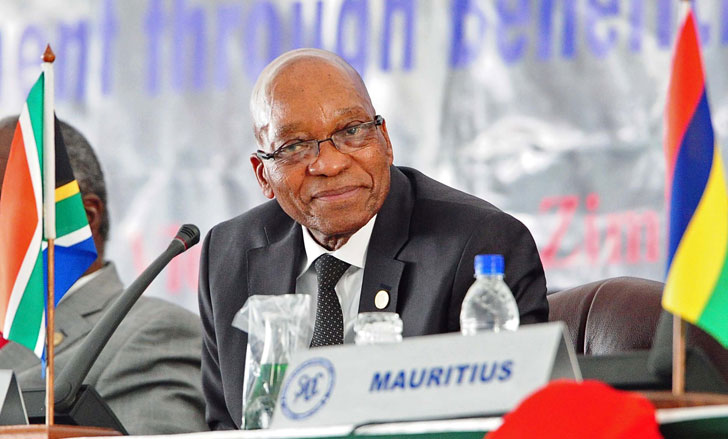 |
| |
| The Southern African Development Community (SADC) 15 Heads of State and Government, who met for their summit at Victoria Falls, in Zimbabwe, unanimously agreed that South Africa should chair the crucial Troika. The Troika is responsible for promoting peace and security in the SADC region. |
| |
The Minister of International Relations and Cooperation, Minister Maite Nkoana-Mashabane, said South Africa’s re-election to chair the SADC Organ for Politics and Defence Troika was an affirmation of the confidence the regional body had in Pretoria.
Lesotho was scheduled to take over the leadership of the security organ from Namibia. However, it’s believed the country’s internal political problems led SADC leaders to give the position to South Africa.
“This goes to the respect and honour that our region and our continent accords to South Africa, respecting the leadership of South Africa in matters of peace and security. In politics they say respect for leadership is earned, you command leadership, you don’t demand it,” Minister Nkoana-Mashabane said on the sidelines of the summit.
She said SADC felt that Lesotho still needed to be “accompanied” to conclude the political consultation process in that country, but Lesotho remained the deputy chair of the Troika.
One of the key issues discussed at the two-day meeting was industrialisation and beneficiation of the region’s mineral resources. – Source:SAnews.gov.za |
|
| |
|
| |
| SA TO INCREASE MEASURES AGAINST RHINO POACHING |
| |
|
|
| Addressing a media briefing on the outcomes of the 2013 rhino census conducted in the Kruger National Park (KNP), the Minister said SA would continue to push strategies to stabilise the rhino population. |
|
|
| |
Environmental Affairs Minister Edna Molewa says South Africa will build on its robust measures to curb the incidence of rhino poaching within its borders. South Africa is home to 82% of Africa’s rhino – both black and white – 93% of Africa’s white rhino and 39% of Africa’s black rhino. SANParks conducts periodic population surveys. As of 2012, South Africa’s rhino population was estimated at 21 000.
Minister Molewa said government was cognisant of the fact that rhino poaching was a multibillion dollar worldwide illicit trade. This, she said, was the reason they would put more emphasis on the Integrated Strategic Management approach to save rhinos from poachers. The approach is aimed at reducing the threat to rhinos and their biological management.
Minister Molewa said South Africa would continue to work with other countries to curb poaching.
She added that forensic technology, including DNA analysis, in the judicial process wouldl be introduced to support the successful prosecution of alleged wildlife criminals. – Source: SAnews.gov.za |
|
| |
|
| |
| MINISTER PANDOR DISCUSSES NAMIBIA'S BID TO HOST THE CHERENKOV TELESCOPE ARRAY |
| |
| South Africa enjoys good science and technology relations with Namibia, and the meeting also reflected on both bilateral and multilateral partnerships in which the two countries were involved. |
| |
 |
| |
The Minister of Science and Technology, Naledi Pandor, and a delegation of senior officials from South Africa, recently met the Namibian Parliamentary Committee on Science and Technology to discuss and grow support for Namibia's bid to host the Cherenkov Telescope Array (CTA).
Minister Pandor also used the visit to Namibia for further discussions on the African Very Long Baseline Interferometry Network, and to brief her Namibian counterpart, Minister David Namwandi, on matters related to the Square Kilometre Array radio telescope.
The CTA will be the world’s biggest gamma ray observatory, 10 times more powerful than current instruments. It will consist of two arrays, one in each hemisphere. A decision on where to host it is due to be announced later this year. Namibia is competing against Chile to host the southern hemisphere portion of the CTA near the remote railway town of Aus.
The CTA consortium currently consists of over a thousand scientists working in more than 170 research institutes in 28 countries (Argentina, Armenia, Australia, Austria, Brazil, Bulgaria, Croatia, the Czech Republic, Finland, France, Germany, Greece, India, Ireland, Italy, Japan, Mexico, Namibia, the Netherlands, Norway, Poland, Slovenia, South Africa, Spain, Sweden, Switzerland, the Unted Kingdom and the Unted States).
The South African institutions involved are North-West University, the University of the Free State, the University of Johannesburg and the University of the Witwatersrand. |
|
| |
|
| |
| SOUTH AFRICAN FILM INDUSTRY EYES CLOSER TIES WITH HOLLYWOOD |
| |
| Minister Davies said his visit had sought to strengthen ties between South Africa's film industry and studios, including 20th Century Fox, Marvel, Sony, NBC Universal and Disney, and to profile the country as a location of choice for films from the United States (US). |
| |
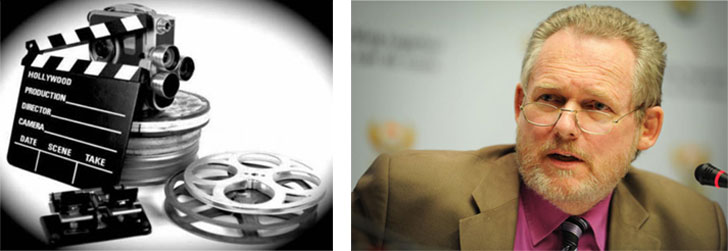 |
| |
Following Trade and Industry Minister Rob Davies' visit to Hollywood recently, the Department of Trade and Industry (dti) would be leading a delegation of South African filmmakers to Los Angeles to engage with the major studios, the Minister announced.
He said all the studios had been "extremely positive" about their experiences of shooting productions in South Africa, including the environment, local production crews, and interactions with the dti on its film incentive programme.
Minister Davies said South Africa's film industry had in recent years made significant progress across the board, including in the hosting of foreign films "which are using South African technicians, camera crews, actors, film stages, locations, as well as post-production services like animation capacities".
The Cape Town Film Studio, built in 2009 with support from the Government, was widely recognised as a world-class facility, Minister Davies noted. He added that a further R6 million was made available in 2012 for the construction of a water tank facility that was being used for the blockbuster TV production Black Sails, which was currently airing in the US.
"To date, more than 10 productions, including Safe House, Chronicle, Judge Dredd and The Borrowers, have utilised the studio facilities, creating in excess of 30 000 job opportunities."
Minister Davies also announced that the threshold for filmmakers to qualify for the dti’s incentive scheme would be lowered from R10 million to R500 000, in order to enable smaller entrants to break into the industry.
In addition, last month the dti, together with the Industrial Development Corporation and the National Film and Video Foundation, launched a new, R90-million Emerging Black Filmmakers Fund.
Each year, for the next three years, the fund will bankroll the full R5-million production and marketing budget of six qualifying feature films – movies that are both directed and produced by black South Africans, or in which a black producer owns at least 51% of the film's production company.
According to a study published by the National Film and Video Foundation last year, the film sector contributes R3.5-billion to South Africa's gross domestic product, while providing employment for more than 25 000 people.
– Source: www.southafrica.info |
|
| |
|
| |
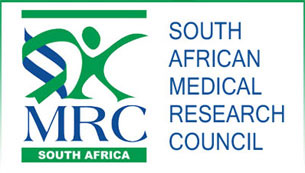 |
|
| PARTNERSHIP TO FAST-TRACK LIFE-SAVING HEALTH INNOVATIONS |
|
|
| |
| The GHIA will aim to push through these barriers to translate the best ideas from South Africa and around the world into widespread use, by shifting the nexus of global health innovation to the people who know Africa's needs best: Africans themselves. |
| |
The South African Medical Research Council and international non-profit organisation Path have launched a new partnership to speed up the development of sustainable, high-impact health innovations capable of saving the lives of vulnerable women and children in South Africa and beyond.
The Global Health Innovation Accelerator (GHIA), launched in Cape Town recently, will combine the resources and expertise of the Government, academia and private partners to advance the design and manufacture of safe, low-cost, medically approved and culturally appropriate products to meet the urgent health needs of South Africa's poorest, most vulnerable women and children. Source: www.southafrica.info |
|
| |
|
| |
| SA DELEGATION BRINGS BACK NAT NAKASA'S REMAINS |
| |
|
| |
| The Government has been involved in the efforts to return Nakasa's remains for the past two years. |
| |
The Minister of Arts and Culture, Nathi Mthethwa, led a South African delegation to the United States (US) to bring back the remains of exiled writer and journalist Nathaniel Ndazana Nakasa – better known as Nat Nakasa – for reburial on home soil.
This comes after the Supreme Court of the State of New York, County of Westchester, granted permission for Nakasa's remains to be returned to South Africa.
Nakaza, who was a pioneer in South African journalism, was awarded a Nieman Fellowship in 1964 to study journalism at Harvard College in the US. However, the apartheid government rejected his application for a passport. As a result, he was forced to leave South Africa on an exit permit, which meant that he could not return.
His death by suicide was an apartheid tragedy, and a tragedy of exile. He wrote articles for several newspapers after leaving Harvard, appeared in the television film The Fruit of Fear and was planning to write a biography of Miriam Makeba. But two days before his death, he told a friend: "I can't laugh any more, and when I can't laugh, I can't write."
As it was not possible to bring his body home, he was buried at the Ferncliff cemetery in upstate.
– Source: www.southafrica.info |
|
| |
|
| |
|
|
| AFRICA'S GROWTH POTENTIAL - AND ITS 'NEXT 10' BIGGEST CITIES |
| |
|
|
| |
| Most major international corporations are already active in at least one of the three largest cities in sub-Saharan Africa – Lagos in Nigeria, Kinshasa in the Democratic Republic of Congo (DRC), and Johannesburg in South Africa. |
| |
Global investors are increasingly taking note of the untapped potential of sub-Saharan Africa, particularly its unparalleled demographic edge. According to a new report by PricewaterhouseCoopers (PwC), Africa will be enjoying faster economic growth than any other region – and will have the world's biggest labour force.
However, PwC economists believe investors should also be getting excited about the "Next 10" biggest cities in sub-Saharan Africa, namely Dar es Salaam (Tanzania), Luanda (Angola), Khartoum (Sudan), Abidjan (Côte d'Ivoire), Nairobi (Kenya), Kano and Ibadan (Nigeria), Dakar (Senegal), Ougadougou (Burkina Faso), and Addis Ababa (Ethiopia).
According to PwC's latest Global Economy Watch report, the population of these cities is projected to almost double by 2030, growing by around 32-million people. In fact, the latest United Nations projections indicate that, by 2030, two of the "Next 10" – Dar es Salaam and Luanda – could have bigger populations than London has now.
Cities are the typical entry points for businesses looking to expand into new markets, because they enable closer interaction with customers in a relatively small geographical area.
"The report projects that economic activity in the 'Next 10' cities could grow by around US$140 billion by 2030," Stanley Subramoney, strategy leader for PwC's south market region, said in a statement.
Roelof Botha, economic adviser to PwC, said that, in addition to high rates of GDP growth, rapid urbanisation and the so-called demographic edge, "a number of other economic phenomena in the region are starting to appeal to the global investment community". These include:
- significant new discoveries of mining and energy resources, in particular gold and gas
- substantial investment in infrastructure and capital formation by the private sector, which has witnessed an increase in the ratio of total fixed investment to gross domestic product from 17,7% in 2000 to an estimated 23% in 2013
- sustained growth in per capital incomes, which has led to demand shifts that are benefiting household consumption expenditure on durables, semi-durables and services
- the ability of a growing number of countries to raise financing for infrastructure projects on the international capital market, in particular Kenya and Rwanda.
– Source: www.southafrica.info |
|
| |
|
| |
| DEPUTY MINISTER MASINA ADDRESSES THE NIGERIA-SOUTH AFRICA CHAMBER OF COMMERCE BREAKFAST FORUM |
| |
| The breakfast forum was hosted by Brand SA and discussed Africa’s competitiveness – Nigeria-South Africa, cooperation or competition. |
|
|
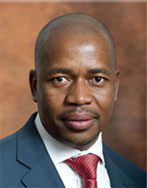 |
|
| |
The Deputy Minister of Trade and Industry, Mzwandile Masina, addressed the Nigeria-South Africa Chamber of Commerce (NSACC) breakfast forum which will take place in Lagos, Nigeria on 21 August 2014.
Deputy Minister Masina said the platform provided by the NSACC was a great one and would ensure that the two biggest economies in the continent begin a process of collaboration which would benefit the continent at large.
“The NSACC is probably the most vibrant and active Chamber of Commerce in Nigeria and was set up in 2000 to promote bilateral trade relations between Nigeria and South Africa,” says Masina.
According to Masina, at the recently concluded World Economic Forum, it was revealed that with the volume currently taking place within Africa, Africa could trade successfully among its countries.
Members of the NSACC include Stanbic IBTC Bank, Honeywell Group, Philips Consulting, Old Mutual, First Bank, South African Airways, Southern Sun, MTN, Multichoice, SAB Miller and Unilever. |
|
| |
|
|
|
|
|
|
|
|








